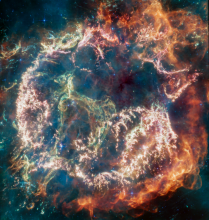Listen to today's episode of StarDate on the web the same day it airs in high-quality streaming audio without any extra ads or announcements. Choose a $8 one-month pass, or listen every day for a year for just $30.
You are here
Faint Ripples
Like waves rippling across the ocean, the aftermath of a stellar explosion is rippling across our region of the galaxy. It forms a thin arc that runs between the big and little dippers.
Astronomers first saw evidence of the ripples in 2006. A space telescope detected a thin, straight line produced by X-rays. It was a couple of degrees long — the width of your finger held at arm’s length.
A few years ago, other astronomers followed up on the discovery. And they found that the line kept on going. It forms an arc that’s 30 degrees long — three times the width of your fist. It extends from near the outer edge of the bowl of the Big Dipper to the handle of the Little Dipper.
X-rays indicate that the arc is a shock wave — something that’s plowing through the gas and dust between the stars. It appears to be the aftermath of a supernova — an exploding star.
The explosion took place perhaps 100,000 years ago, about 600 light-years from Earth. Debris from the star’s outer layers was blasted into space at up to a few percent of the speed of light. That bubble of gas and dust continues to expand, getting thinner, cooler, and fainter. So today, all that’s visible is a long, thin strand at the edge of that expanding bubble — an arc between the dippers.
The Big Dipper is in the northeast at nightfall, standing on its handle. The Little Dipper is to the left. Its bowl hangs below the handle, which ends at Polaris, the North Star.
Script by Damond Benningfield





